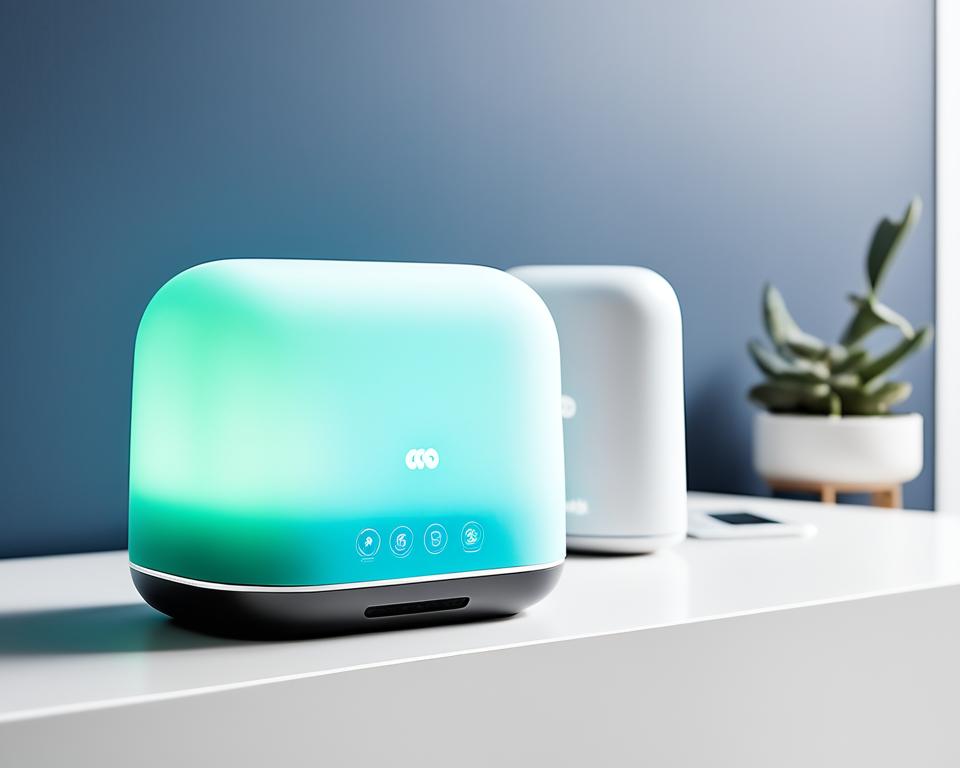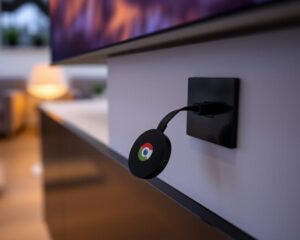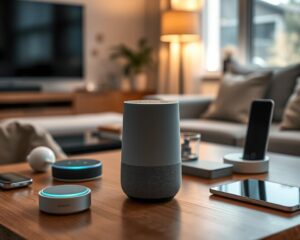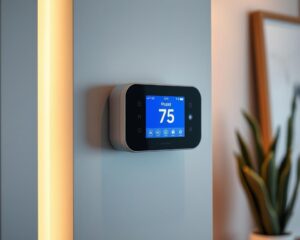

Philips Hue Bridge - Unlock the Full Potential of Hue - Multi-Room and Out-of-Home Control
$50 - $60

Aeotec Smart Home Hub, Works as a SmartThings Hub, Z-Wave, Zigbee, Matter Gateway, Compatible with Alexa, Google Assistant
$110 - $130
As the world of smart home technology continues to evolve, the need for a centralized control system becomes increasingly important. Smart home hubs have emerged as the solution, serving as the brain that orchestrates your various smart devices, from lights and locks to thermostats and cameras. With so many options on the market, it can be daunting to choose the right smart home hub for your needs.
Whether you’re just starting to build your smart home or looking to upgrade your existing setup, this guide will help you navigate the world of smart home hubs and find the perfect one for your home. From understanding the benefits of a smart home hub to exploring the different types of hubs available, we’ll cover everything you need to know to make an informed decision and take your smart home to the next level.
Smart Home Hub: The Centralized Brain
As the smart home revolution continues to transform our living spaces, a crucial component in this technological evolution is the smart home hub. A smart home hub is a central device that acts as the nerve center, coordinating and managing all the various smart devices in your home.
What is a Smart Home Hub?
A smart home hub is a device that serves as the “brain” of your smart home. It connects to your home’s Wi-Fi network and allows you to control, automate, and integrate all your connected devices, from smart lights and security cameras to voice assistants and appliances. This centralized control simplifies the management of your smart home ecosystem, making it more efficient and user-friendly.
Benefits of a Smart Home Hub
The key advantages of incorporating a smart home hub into your connected home include:
- Centralized Control: A smart home hub provides a single interface to manage all your smart devices, eliminating the need to juggle multiple apps or remote controls.
- Seamless Integration: The hub enables seamless communication and coordination between your various smart home products, regardless of their underlying protocols or brands.
- Faster Response Times: By processing commands locally, a smart home hub can respond to your requests more quickly than cloud-based solutions, resulting in a more responsive and reliable smart home experience.
- Advanced Automations: Smart home hubs allow you to create complex routines and automations that link multiple devices together, enabling sophisticated home control and optimization.
With a smart home hub at the center of your connected home, you can simplify the management of your smart devices, unlock greater automation capabilities, and enjoy a more cohesive and efficient smart home experience.
Multi-Protocol Hubs: Versatility Redefined
In the ever-evolving landscape of smart home technology, multi-protocol hubs have emerged as the pinnacle of versatility. These innovative devices are designed to seamlessly integrate a diverse array of smart devices, regardless of the underlying communication protocols they utilize. Whether your smart home ecosystem includes Zigbee, Z-Wave, Wi-Fi, Bluetooth, or the cutting-edge Matter standard, a multi-protocol hub can bring it all together under a single, intuitive interface.
The true power of a multi-protocol hub lies in its ability to transcend the limitations of individual device protocols. By supporting a wide range of communication standards, these hubs ensure that your smart home can grow and evolve without being constrained by the specific technologies employed by your devices. This hub interoperability allows you to mix and match smart products from various manufacturers, creating a dynamic and future-proof smart home ecosystem.
Beyond the ability to connect a myriad of devices, multi-protocol hubs also offer unparalleled hub versatility. These advanced smart home hub solutions provide centralized control and management, empowering you to monitor, automate, and optimize your entire smart home from a single, intuitive interface. Whether you’re adjusting lighting, managing climate, or securing your property, a multi-protocol hub puts the power of a truly integrated smart home at your fingertips.
| Feature | Benefit |
|---|---|
| Multi-protocol compatibility | Connects a wide range of smart devices, regardless of their communication protocol |
| Centralized control | Manages and automates your entire smart home ecosystem from a single interface |
| Future-proof versatility | Allows your smart home to grow and evolve without being limited by protocol constraints |
As the smart home revolution continues to unfold, multi-protocol hubs stand as the pinnacle of hub versatility and hub interoperability, empowering users to build seamless, future-proof smart home ecosystems that adapt to their evolving needs.
Platform/Ecosystem Hubs: Seamless Integration
In the world of smart home technology, platform or ecosystem-specific hubs have emerged as a popular choice for users seeking a tightly integrated experience. These hubs, often incorporated into smart speakers or other devices, are designed to work seamlessly within a particular smart home ecosystem, such as the Amazon Alexa or Google Home platforms.
Amazon Alexa Hubs
The Amazon Echo line of smart speakers, including the Echo Dot and Echo Show, serve as the centerpiece of the Alexa smart home ecosystem. These Alexa hubs provide users with a voice-controlled interface to manage a wide range of compatible smart home devices, from lights and thermostats to security cameras and appliances. The tight integration between the Alexa hub and the corresponding mobile app offers a streamlined and user-friendly smart home experience.
Google Home Hubs
On the other hand, Google Home hubs, such as the Google Nest Hub Max, offer a similar level of integration within the Google Home ecosystem. These hubs seamlessly integrate with the Google Assistant, allowing users to control compatible smart devices, view security camera feeds, and even manage their Google Calendar and other Google services through voice commands or the mobile app.
While platform hubs may have more limited protocol support compared to multi-protocol hubs, they excel at delivering a streamlined and user-friendly smart home smart home integration experience within their respective ecosystems. This makes them an attractive choice for those who are deeply invested in a particular smart home ecosystem hub.
Smart hub: The Key to Interoperability
A smart home hub plays a crucial role in achieving smart home interoperability. By acting as a central control point, a hub can bridge the gaps between different device compatibility and cross-platform integration, allowing you to seamlessly control and integrate devices from multiple manufacturers. This hub interoperability is essential for creating a truly cohesive and responsive smart home, where all your connected devices work together harmoniously, regardless of the underlying technology.
A well-chosen smart home hub can help you overcome the challenges of fragmentation and ensure that your smart home functions as a seamless, interconnected system. With a hub, you can easily manage and control a wide range of smart devices, from lighting and security systems to climate control and appliances, all from a single interface.
The key to smart home interoperability lies in the hub’s ability to communicate with various protocols and ecosystems. Whether your home is equipped with Zigbee, Z-Wave, or Matter-enabled devices, a compatible hub can bridge the gaps and enable smooth integration, ensuring that your smart home functions as a cohesive and responsive system.

By investing in a reliable smart home hub, you can unlock a world of possibilities, where your connected devices work together seamlessly, providing enhanced convenience, efficiency, and control over your living environment. Embrace the power of hub interoperability and transform your home into a truly smart and integrated space.
Zigbee, Z-Wave, and Matter: Protocols Demystified
Smart home devices often rely on specialized communication protocols to connect and communicate with each other, and with a central hub. Understanding these protocols is crucial for building a well-functioning smart home. Let’s explore the key smart home protocols that are shaping the future of connected living.
Understanding Zigbee
Zigbee is a low-power, mesh networking protocol that is widely adopted in the smart home industry, particularly for devices like lights, sensors, and switches. Its mesh network capabilities allow for reliable and energy-efficient communication, making it a popular choice for smart home automation.
Exploring Z-Wave
Z-Wave is another prominent low-power protocol in the smart home space. It excels at creating robust, self-healing mesh networks, ensuring reliable connectivity even in complex home environments. Z-Wave-enabled devices are known for their seamless integration and interoperability.
The Rise of Matter
The new Matter standard, developed by a consortium of tech giants, aims to provide a universal language for smart home devices. By facilitating seamless interoperability across platforms and ecosystems, Matter promises to revolutionize the way we build and experience smart homes.
Choosing a smart home hub that supports these key protocols – Zigbee, Z-Wave, and Matter – can ensure greater compatibility and flexibility for your smart home setup, allowing you to mix and match devices from different brands and ecosystems with ease.
Bridges and Gateways: Single-Platform Solutions
In the world of smart home technology, not all hubs are created equal. Alongside the versatile multi-protocol and platform-specific hubs, there exists a unique category of devices known as smart home bridges and smart home gateways. These single-platform solutions are designed to seamlessly integrate with specific smart home ecosystems, offering a tightly integrated experience for users deeply invested in a particular brand or platform.
Bridges and gateways, such as the Philips Hue Bridge or the Aqara Hub, are often manufacturer-specific, catering to the needs of users who prefer to stay within a single smart home ecosystem. While these devices may have a more limited range of compatible products compared to universal hubs, they can provide a streamlined and efficient smart home experience, with enhanced integration and control over the supported devices.
One key advantage of single-platform hubs is their ability to simplify the setup and management of smart home devices. By focusing on a specific ecosystem, these bridges and gateways can offer a more intuitive and user-friendly interface, reducing the complexity often associated with juggling multiple protocols and platforms. This can be particularly beneficial for those new to the world of smart home technology, who seek a hassle-free way to integrate their devices and automate their living spaces.
Moreover, bridges and gateways can also serve as a complementary solution when used in conjunction with multi-protocol hubs. By connecting these manufacturer-specific hubs to a universal hub, users can expand the range of compatible devices within their smart home, enjoying the best of both worlds – the convenience of a single-platform experience and the versatility of a multi-protocol system.
As the smart home ecosystem continues to evolve, bridges and gateways will likely play an increasingly important role in providing seamless integration and control over a diverse range of smart devices. Whether you’re a seasoned smart home enthusiast or just starting your journey, understanding the capabilities of these single-platform solutions can be a valuable asset in creating a truly cohesive and efficient smart home experience.
Future-Proofing Your Smart Home
As you build out your smart home, it’s crucial to consider the long-term future-proofing of your setup. The recently launched Matter standard, backed by major tech companies, promises to revolutionize smart home interoperability by providing a universal language for devices to communicate. This breakthrough offers a path to seamless integration and enhanced compatibility, ensuring your smart home ecosystem remains relevant and adaptable for years to come.
Embracing Matter
When selecting a smart home hub, look for one that is Matter-compatible. This will ensure your hub can seamlessly integrate with a wider range of smart home products in the future, paving the way for a more versatile and future-proof setup. By aligning your smart home with the Matter standard, you can future-proof your investment and enjoy the benefits of enhanced interoperability as the technology continues to evolve.
Upgrading to Advanced Systems
For power users seeking greater control and customization options, exploring more advanced smart home systems, such as open-source platforms like Home Assistant or Hubitat, may be a compelling option. These platforms offer granular control and extensive customization capabilities, allowing you to tailor your smart home to your unique needs and preferences. By being open to upgrading your smart home ecosystem, you can ensure your setup continues to meet your evolving requirements and keeps pace with the latest advancements in smart home technology.
By embracing the latest standards, such as Matter, and being open to upgrading your smart home ecosystem, you can future-proof your setup and ensure it continues to meet your needs as the technology evolves. This forward-thinking approach will allow you to get the most out of your smart home investment and enjoy a seamlessly integrated, future-proof living experience.
Top Smart Home Hubs: A Comprehensive Guide
When it comes to finding the best smart home hub for your needs, there are several top-tier options to consider. The Amazon Echo is a versatile hub that works seamlessly with Alexa, supporting a wide range of smart home protocols, including Zigbee, Bluetooth, and the new Matter standard. For those seeking a more versatile solution, the Aeotec Smart Home Hub is compatible with the Samsung SmartThings ecosystem and supports Zigbee, Z-Wave, and Matter.
Google Home users will find the Google Nest Hub Max to be a capable smart display that can serve as a central hub for their Google Home-compatible devices. And for Apple HomeKit enthusiasts, the Apple HomePod (2nd generation) is a premium smart speaker that can act as a powerful smart home hub. Ultimately, the best smart home hub for you will depend on your specific setup, ecosystem preferences, and future needs.
When comparing the top smart home hubs, it’s important to consider factors such as compatibility, ease of use, and the breadth of smart home devices they support. By carefully evaluating the available options, you can find the perfect hub to centralize and streamline your smart home experience.






